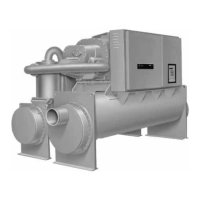Temperature Sensors
16 RTHC-SVD01B-EN
measure the DC voltage across the sensor leads at the terminal or
probe the screws on the Phoenix connector.
Note: Always use a digital volt-ohmmeter with 10 megohm or
greater impedance to avoid “loading down” the voltage divider.
Failure to do so will result in erroneously high temperature calcu-
lations.
10. Locate the appropriate sensor table and then compare the tem-
perature in the table corresponding to the voltage reading
recorded in step 9 with the actual temperature observed in step 8.
If the actual measured temperature falls within the allowable toler-
ance range, both the sensor and the UCP2 input circuits are oper-
ating properly. However, if the actual temperature is outside the
allowable sensor tolerance range, proceed with step 11.
11. Again measure the temperature at the sensor with an accurate
thermometer; record the temperature reading observed.
12. Remove the sensor leads from the terminal strip or unplug the
respective Phoenix connector. Measure the resistance of the sen-
sor directly at the sensor leads or probe the Phoenix connector
with a digital volt-ohmmeter. Record the resistance observed.
13. With the sensor still disconnected from the module, check the
resistance from each of the sensor leads to the control panel
chassis. Both readings should be more than 1 megohm. If not, the
sensor or the wiring to the sensor is either shorted or leaking to
chassis ground and should be replaced.
14. Select the appropriate sensor table and locate the resistance
value recorded in step 12. Verify that the temperature corre-
sponding to the resistance value matches the temperature mea-
sured in step 11. The values should fall within the tolerance
ranges noted in the table.
15. If the temperature sensor is out of range, the problem is either the
sensor, wiring, or the Phoenix connector. If the Phoenix connector
is used and the thermistor reads open, first disconnect the leads
from the Phoenix connector. Remove a small amount of insulation
on the leads and repeat the measurements directly. Once the
fault is isolated, install a new sensor, connector or both.

